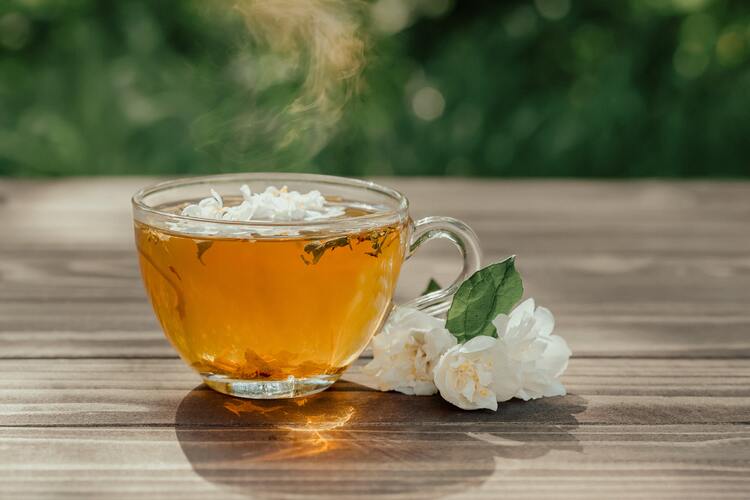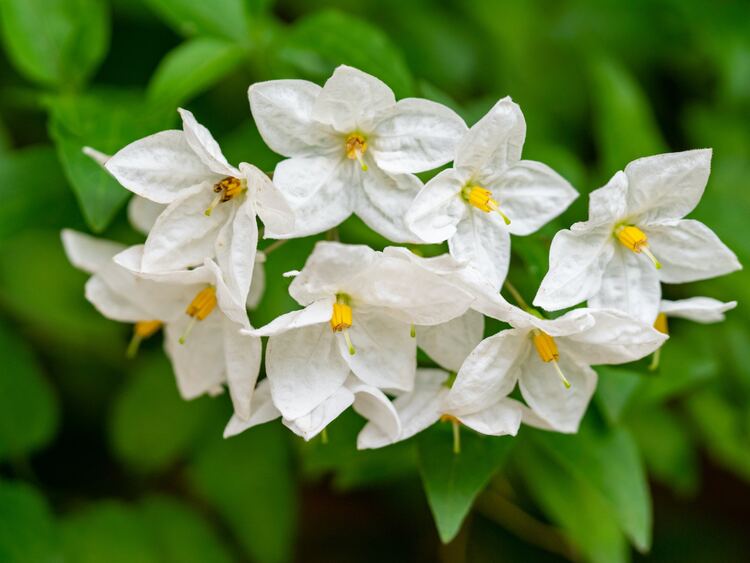Green Tea vs Jasmine Tea. We explore the differences.
When it comes to tea, there are countless varieties to choose from. Green tea and jasmine tea are two options that stand out. While both teas come from the same plant, Camellia sinensis, they are processed and flavored differently, resulting in distinct taste profiles.
Green tea is known for its grassy, earthy flavor and is often praised for its high concentration of antioxidants. On the other hand, Jasmine tea is a scented tea typically made by mixing green tea leaves with jasmine flowers. The flowers are left to infuse with the tea leaves, producing a floral and slightly sweet taste.
We’ve got you covered if you’re trying to decide between these two teas. Keep reading since we have tons of information to share.
Please note: This article contains affiliate links, meaning I may earn a commission if you make a purchase by clicking a link. Of course, this comes at no extra cost to you and helps me keep offering readers solid information.

Green Tea vs Jasmine Tea: Overview
Let’s start by better understanding what green tea and jasmine tea are.
Green Tea
Green tea is made from the leaves of the Camellia sinensis plant. The leaves are steamed or pan-fired to stop oxidation (darkening of the leaves), which helps preserve the green color and flavor of the tea. Green tea is known for its light, vegetal taste and its high concentration of antioxidants.
There are many different types of green tea, including Chinese and Japanese green teas. Some popular varieties include Dragonwell, Sencha, and Matcha. Green tea can also be blended with other ingredients, such as mint or lemon, to create unique flavors.
Jasmine Tea
Jasmine tea is a type of scented tea that is made by blending green tea with jasmine flowers. The tea leaves are layered with jasmine blossoms and left to absorb the floral aroma overnight. The next day, the jasmine flowers are removed, leaving a tea with a delicate, floral taste and aroma.
Jasmine tea can be made with different types of base tea, including black tea, white tea, and oolong tea. However, green tea is the most common base.
Green Tea vs Jasmine Tea: Comparison
With a better understanding of both teas, let’s get a detailed comparison.
- Type of Tea: Green tea is one of the major types of tea (what is known as a true tea). It is made from the leaves of the Camellia sinensis plant. Jasmine tea is not a standalone tea type but a flavored tea.
- Processing: For green tea, the tea plant leaves are picked and then immediately steamed or pan-fired to stop the oxidation process. Oxidation is the process by which tea leaves are exposed to oxygen, causing them to change color and flavor. Oxidation is stopped by applying heat. After steaming or pan-firing, the leaves are rolled, dried, and packaged. Jasmine tea is often made using green tea as a base. Once the tea leaves go through the green tea process, they are mixed with jasmine flowers and left to absorb the scent of the flowers. This process can take several hours to several days, depending on the desired strength of the jasmine flavor. Scenting can be seen as part of green tea’s post-processing.
- Flavor: Green tea typically has a grassy, vegetal flavor profile that can be slightly bitter. However, some green teas may also have a sweet flavor, similar to honey or sugar. On the other hand, jasmine tea has a unique floral taste that is sweet and refreshing.
- Aroma: Green tea has a fresh and grassy primary aroma. Some varieties may also have slightly nutty or seaweed-like notes. Jasmine tea has a distinctive floral aroma that can be quite calming.
- Caffeine Content: Green and jasmine tea contain caffeine, but the amount can vary depending on the type of tea, brewing method, and steeping time. The difference in caffeine content per cup is minimal.

Brewing Techniques and Considerations
When it comes to brewing these teas, there are a few techniques and considerations you should keep in mind to ensure that you get the best flavor out of your tea.
Steeping Time
The steeping time for both teas is crucial to achieve the perfect balance of flavor and aroma. Generally, green tea should be steeped for 2-3 minutes, while jasmine tea should be steeped for 3-4 minutes. Steeping for too long can produce a bitter taste, while steeping for too short can produce a weak flavor.
Boiling Water
Both teas can be brewed with water that is around 160°F (71°C) to 180°F (82°C). If you don’t have a thermometer, you can boil the water and let it cool for a couple of minutes before using it.
Filtered Water
Filtered water is always recommended when brewing tea, as it can significantly improve the flavor and aroma. Tap water can contain impurities that can affect the taste of your tea, so using filtered water can help ensure a cleaner, better-tasting cup.
Brewing Techniques
You can use several brewing techniques when brewing green and jasmine teas. Here are a few to consider:
- Covered Cup or Gaiwan: This method involves warming the cup or gaiwan and adding the tea leaves and hot water. Then, the brewing vessel is covered with a lid while the leaves are steep. This is the recommended brewing method to obtain the best flavor.
- Grandpa Style: This method involves placing the tea leaves directly in a cup and adding hot water. It’s a simple and convenient way to brew tea, but it can produce a weaker flavor.
- Western Style: This method involves using a larger teapot. It’s a good option if you want a more robust flavor and don’t have much time.

Health Benefits and Nutritional Differences
When it comes to health benefits, both green tea and jasmine tea have a lot to offer. Here are some of the specific benefits and differences between the two:
General Health Benefits
Both green tea and jasmine tea are rich in antioxidants, which can help protect your body against damage from free radicals. Antioxidants are also known to have anti-aging properties.
Weight Loss and Metabolism
Green tea has been shown to boost metabolism and promote fat burning, making it a popular choice for those looking to lose weight. On the other hand, Jasmine tea may help regulate blood sugar levels and reduce cravings for sugary foods.
Heart and Brain Health
Green and jasmine tea have been linked to improved heart health and a lower risk of heart disease. Green tea also improves brain function and memory, while jasmine tea may help reduce anxiety and promote relaxation.
Oral Health and Anti-Inflammatory Properties
Green tea has anti-inflammatory properties, which can help reduce inflammation throughout the body. It has also been shown to improve oral health and reduce bad breath. Jasmine tea may help reduce inflammation and promote relaxation.
Caffeine Content and Side Effects
Both teas contain caffeine. On average, an 8-ounce (240 ml) cup of green tea typically contains around 30 to 50 milligrams of caffeine, while a cup of jasmine tea typically contains about 25 to 45 milligrams of caffeine.
If you’re sensitive to caffeine, it’s important to know the potential side effects. Drinking too much caffeine can lead to jitters, nervousness, and an increased heart rate. It can also disrupt your sleep and cause headaches.
However, the amount of caffeine in green tea and jasmine tea is generally lower than coffee and energy drinks, making it a good alternative for those looking to reduce their caffeine intake.
Price, Quality & Recommendations
Green and jasmine tea can be found in premium versions if you are looking for high-quality tea. These teas are typically made from high-quality leaves and are processed carefully to preserve their flavor and aroma. However, premium teas can also be expensive, so if you are on a budget, you may need to look for cheaper options.
When it comes to entry-level teas, green tea is generally less expensive than jasmine tea. This is because green tea is more widely produced and often less labor-intensive. However, this does not necessarily mean that green tea is lower quality. There are many high-quality green teas available at reasonable prices.
One thing to watch out for when buying jasmine tea is artificial flavoring. Some lower-quality jasmine teas are made with artificial flavoring instead of real jasmine flowers. These teas may be less expensive but will not have the same delicate flavor and aroma as a high-quality tea made with real flowers.
A great place to buy these teas is at specialty tea shops. These shops often carry a wide variety of tea blends. Specialty tea shops are also the place to ask questions and get recommendations from knowledgeable staff members who can help you find products according to your preferences and budget.
If visiting a specialty tea shop is not viable, you can look for reputable online tea shops or retailers. You can also read reviews from other customers to get an idea of the quality of the tea and the seller’s reliability.
If you are interested in buying online, please consider the recommendations below.
Davidson’s Organics, Gunpowder Green, Loose Leaf Tea

Numi Organic Tea Gunpowder Green

FGO Organic Jasmine Pearls Green Loose Tea

Numi Organic Tea Jasmine Green

Frequently Asked Questions
What are the benefits of drinking jasmine tea or green tea?
Both jasmine tea and green tea contain antioxidants that can help reduce the risk of chronic diseases, such as heart disease and cancer. Additionally, green tea has been shown to improve brain function and aid in weight loss, while jasmine tea may have calming effects and improve digestion.
Which has more caffeine, jasmine tea or green tea?
The exact amount of caffeine can vary depending on the specific type of tea and brewing method. On average, a cup of green tea contains around 30-50 mg of caffeine, while a cup of jasmine tea contains around 25-45 mg. Therefore, the amount of caffeine in these teas is about the same.
What are the differences between jasmine green tea and oolong tea?
Jasmine green tea is a type of green tea scented with jasmine flowers, giving it a floral aroma and sweet taste. On the other hand, oolong tea is a partially oxidized tea with a range of flavors, from floral to fruity to nutty. While both types of tea can be enjoyed for their unique taste and health benefits, they have distinct flavor profiles and brewing methods.

I hope you have enjoyed the article and learned something new! See you later!
Green tea vs jasmine tea, which one do you prefer?
More About Green Tea
What Does Green Tea Taste Like?
What Does Jasmine Tea Taste Like?